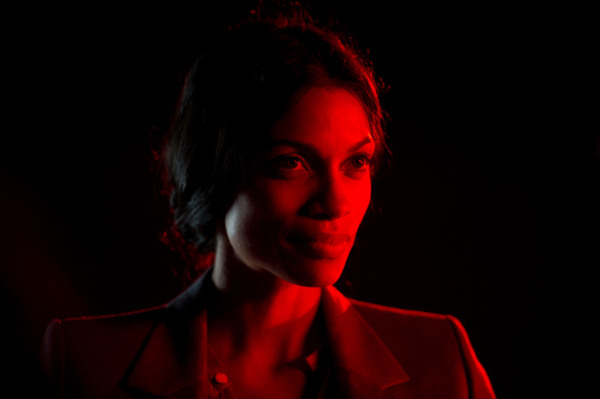 By Armond White
By Armond White
Guys all wanted to sex Rosario Dawson after The 25th Hour where she dressed in schoolgirl drag as the ultimate stroke book fantasy. Dawson is always cast for sultry provocation–sometimes movingly as Channing Tatum’s girl who got away in Ten Years and now outrageously in Trance, Danny Boyle’s latest travesty.
As Elizabeth, the smooth-talking hypnotherapist in the poshest part of London, Dawson’s dark-skinned Amazon strut seems improbable until the pointless plot makes her the focus of a gang of art thieves trying to recover a stolen Goya. Double-dealing auctioneer Simon (James McAvoy) can’t remember where he stashed the Goya. Elizabeth (that name connotes “the queen of women” as Quentin Tarantino once dubbed Pam Grier) realizes that Simon floats in and out of trance easily, so she puts him in a trance to uncover the painting but more importantly she arouses each gang member’s sexual idee fixe.
A smart moviemaker might have had fun tying this frivolous story to the psychological evaluation of painting but Boyle once again rushes into headlong flashiness–over-editing and over-photographing the heist, the violence, the hypnotism, the seductions. He chops-together moderne images of a hideout bar named Analog and uses a thug’s Ipad to symbolize the workings of memory. Boyle specializes in visual diarrhea like the little Indian kids dived into in Slumdog Millionaire.
Critics are eager to swim in Boyle’s slough of “style” (the kind of overblown sound and music manipulation that Spielberg gets accused of) probably because it means nothing. If they pretend that it’s chic entertainment with some cynic blather about “greed” and murder (when Elizabeth asks if a thug ever killed anyone, he responds “Define ‘killed’”), they can ignore the cynicism as anything-goes entertainment.
But a genuinely stylish filmmaker might produce a sexy thriller like Rocknrolla (the ultimate Guy Ritchie film) whereas Boyle merely exploits Dawson’s presence as just another item in his montage of facetious possibilities. Putting a Black woman’s sex at the center of a pretend psychological heist movie without exploring the psychology of race and sexuality is just another dodge–the kind that might be expected from Steven Soderbergh. Trance fails because Boyle doesn’t explore its obvious subject. Why is the stolen painting Goya’s Witches in the Air rather than The Naked Maja where the issue of genital representation matters?
By featuring Dawson’s shaved pudenda as the key to Simon’s psychological block and erotic fixation, Boyle raises issues (and cultural expectation) he isn’t equipped to deal with. (It is not insignificant that this film’s only other black character–a male villain–is castrated before being brutally killed.) Boyle disappoints the jolie laide tradition of sexually compelling women to which Dawson rightly belongs. Her huge eyes, full lips, high, sharp shoulders and long legs challenge the authority of the men she attracts but this is just a Hottentot Venus act. Her speech about defying abuse is Boyle’s p.c. attempt at covering his own ass, as if to excuse the kind of stroke book exploitation that Paul Verheoven in Basic Instinct and Spike Lee in The 25th Hour didn’t bother trying to justify. Somehow, within the trash of Trance, Boyle leaves the dare of Dawson’s sexuality unfulfilled and frustrated.
Follow Armond White on Twitter at 3xchair
